Development of Accommodating Intraocular Lens
Challenge the Surgical Correction of Presbyopia
We are challenging to develop intraocular lenses (IOLs) that moves
in the eye and exerts accommodation power.
Development had progressed until just before clinical trials.
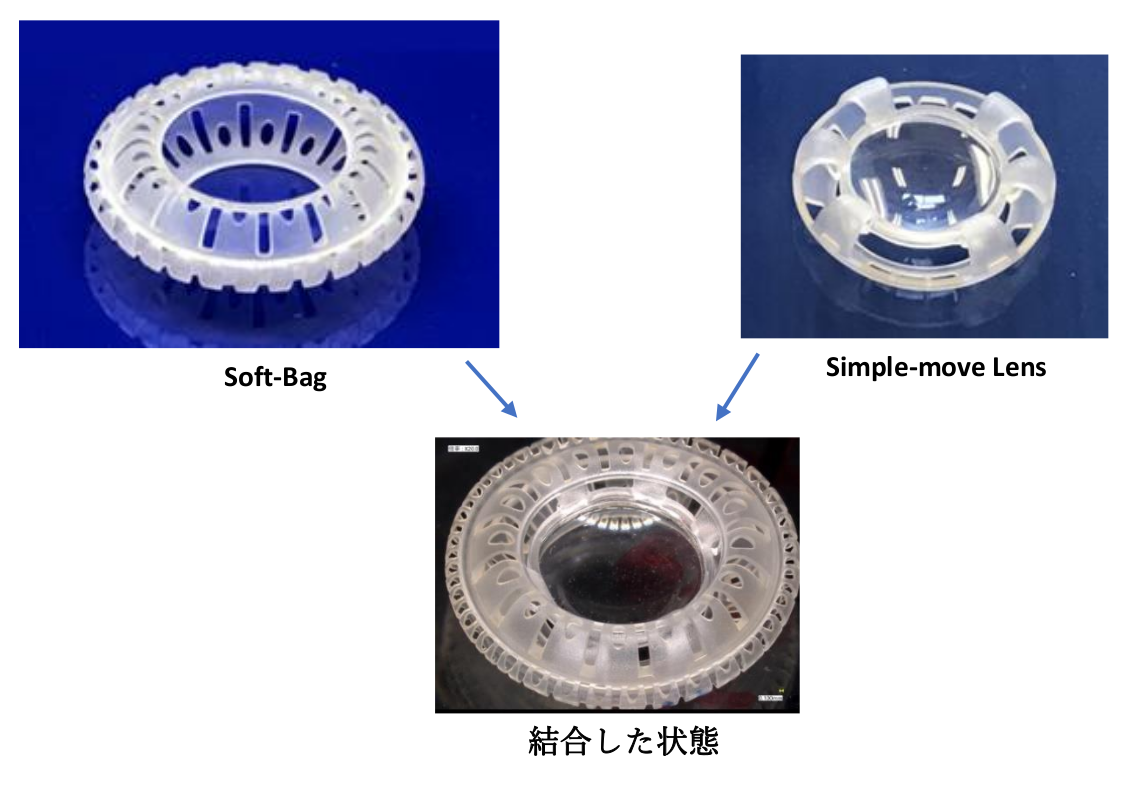
Current Issues of Presbyopia Correction
Accommodation of a Human Lens, Presbyopia and Cataract
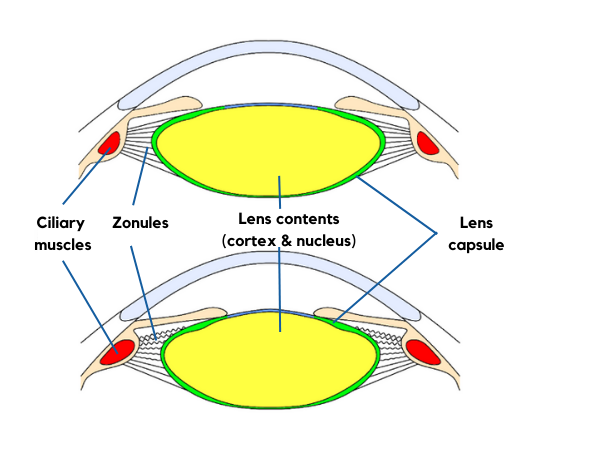
- The accommodation of the human lens is performed by a change in the anterior curvature of the elastic lens. This is induced by ciliary muscle movements transmitted via the zonules.
- The human lens consists of the surface membrane (lens capsule) and the contents (cortex & nucleus).
- Presbyopia is a condition characterized by the hardening of a lens’ contents and the lens’ inability to change shape.
- Cataracts are caused by poor visual acuity due to opacification of the lens contents.
Cataract Surgery and Intraocular Lens (IOL)
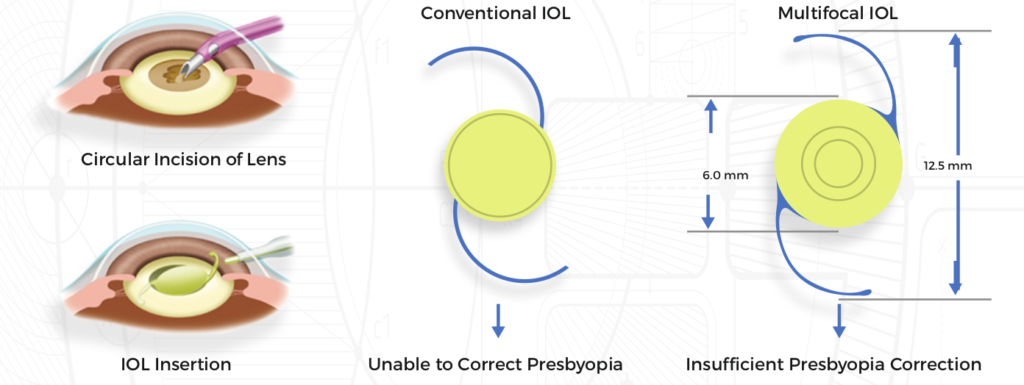
Cataract can be treated by surgery. During cataract surgery, the following procedure is performed:
- The anterior capsule is removed in a circular form. The lens contents (cortex & nucleus) are then removed using an ultrasound machine, and an intraocular lens (IOL) is then placed into the lens capsule.
- However, a conventional IOL has a fixed focal lens and cannot correct presbyopia.
- Currently, multifocal IOLs are used for correcting presbyopia. However, their ability to correct presbyopia is insufficient and it can induce adverse reactions because the light entering the eye undergoes splitting for near and far sightedness.
Accommodating Intraocular Lens Containing Hinges
- Accommodating IOL (A-IOL) can theoretically correct presbyopia completely because the lens optic moves in the capsule by the force of ciliary muscles.
- There is an A-IOL that has plate haptics with hinges. It has been approved by the United States Food and Drug Administration (FDA) and has been marketed in the USA.
- Ultrasound biomicroscopy (UBM) shows almost no movement of the optic during accommodation in that A-IOL.
- Therefore, we think that this A-IOL without a spring cannot move in the capsule.
Accommodating Intraocular Lens Containing Springs
- There is an A-IOL that has two optics (anterior +32 D convex lens, posterior concave lens selected according to the refractive condition) linked with a spring, which had obtained the CE marking before.
- UBM shows the 0.3mm movement of lens optic during accommodation
Problems with conventional A-IOLs
- Conventional A-IOLs move in a simple manner which is followed by ciliary muscle, zonular, and capsular movements. They are restricted to a 0.3mm movement.
- It is an accepted opinion that most A-IOLs are unable to move in the long term due to capsule hardening.
- Additionally, most A-IOLs are large and have problems during insertion. This poses a concern regarding safety and operability
Solutions We Offer for Presbyopia Correction (Part 1)
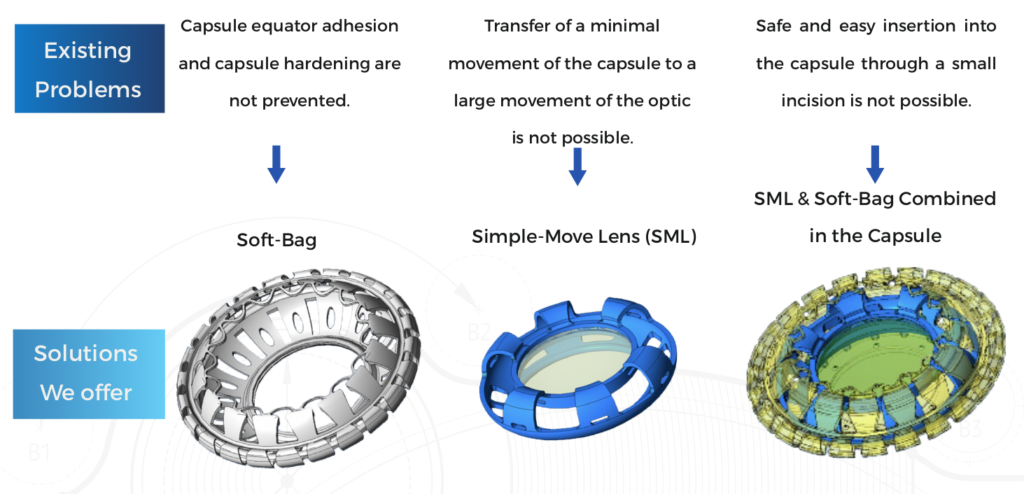
Three problems that need to be solved for the success of accommodating IOLs and the solutions we offer:
- Capsule equator adhesion and capsule hardening cannot be prevented. This can be solved by the use of a Soft-Bag.
- Transfer of a minimal movement of the capsule to a large movement of the IOL optic is not possible. This can be solved by the use of a SML.
- A safe and easy insertion of the IOL into the capsule through a small incision is not possible. This can be solved by inserting the Soft-Bag and the SML into the capsule separately and combining them inside the capsule.
- The accommodation of the human lens is performed by a change in the anterior curvature of the elastic lens. This is induced by ciliary muscle movements transmitted via the zonules.
- The human lens consists of the surface membrane (lens capsule) and the contents (cortex & nucleus).
- Presbyopia is a condition characterized by the hardening of a lens’ contents and the lens’ inability to change shape.
- Cataracts are caused by poor visual acuity due to opacification of the lens contents.
Structure and Function of the Soft-Bag

- The Soft-Bag has a 3D structure made of a silicone membrane with a thickness of 0.1mm. It consists of a bag-shaped structure for expanding a capsular hole and a tube-shaped structure around it for expanding the capsule equator.
- A special ultrashort pulse laser is used to create multiple slits so that the Soft-Bag maintains high deformability and high mobility.
- Due to its surface being treated with an MPC polymer, it contains a similar structure to that of human cells on its surface. This allows the Soft-Bag to maintain high biocompatibility on its surface.
On account of the above-mentioned points, the Soft-Bag expands the capsule equator by changing the shape per the lens size and capsule equator shape. It prevents capsule hardening which is followed by capsule equator adhesion. It also maintains capsular mobility in the long term and transfers the capsular movement to the SML effectively.

- The Simple-Move Lens (SML) has a 3D structure made by connecting the frame part made from silicon and an optic made of acrylic.
- The frame section has six arch-shaped arms which emerge from the outer ring and connect to the optic at the end.
- These arms rotate interior downwards using the outer ring as a pivot by receiving a small movement of the capsule on their upper temporal side. This internal downward movement of the arms converts to a downward movement of the optic. This causes the optic to move significantly with level principle.
- A computer simulation shows that a 0.3mm movement of the arms convert to a 0.87mm movement of the optic. This results in an amplification function of 2.9 times.
Accommodation Function of the Soft-Bag & SML Combination
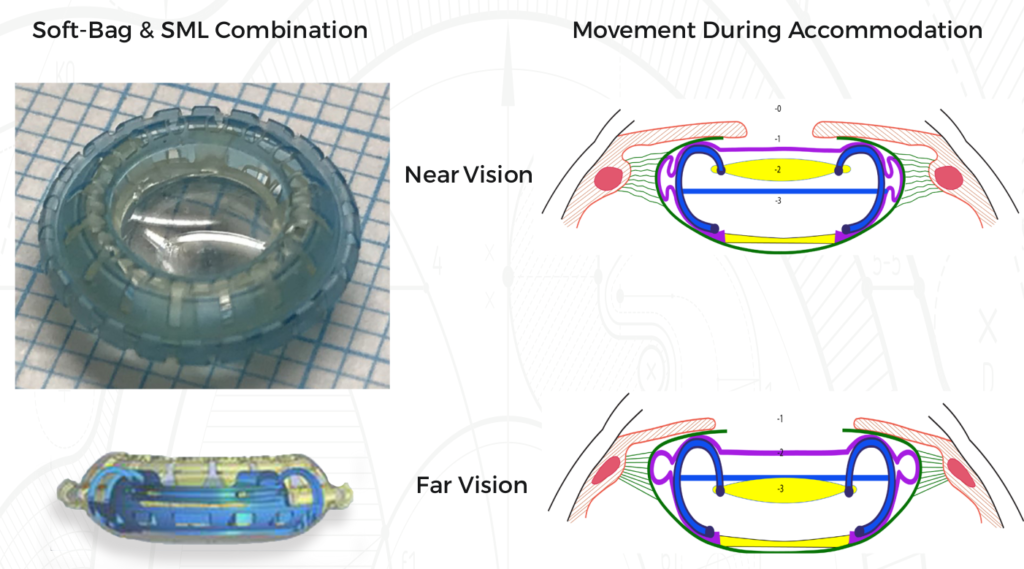
Movement of the Soft-Bag and SML During Accommodation
- The Soft-Bag changes its shape according to the capsule’s movement and tension. It then transmits the capsule movement and tension to the SML.
- For far sight, in its natural state, the ciliary muscle is expanded. It pulls the zonules and the capsule, which then increases their tension and pushes the SMLs arms. The small movement of the arms, which is approximately 0.3mm converts to a large movement of the optic which approximately 0.87mm by the amplification function of the SML.
- For near sight the ciliary muscle contracts and the capsule loses tension. The arms return to their original shape by their spring power. The lens optic then moves anteriorly by approximately 0.87m
Accommodation Power of the Soft-Bag & SML Combination
- The posterior ring of the Soft-Bag has one of three concave lenses which can be -18D, -12D or -6D. The suitable concave lens is selected by a refractive condition. The SML uses a high-power convex lens between +28D to +33D and this creates a strong accommodation function.
- The Soft-Bag and SML Combination induces relatively large accommodation power of approximately 2D (when +28D lens moves 0.87mm) despite back and front movements of a mono-focal lens.
Results of the Soft-Bag & Simple-Move Lens (SML) Combination
Evaluation of Insertion Safety and Operability
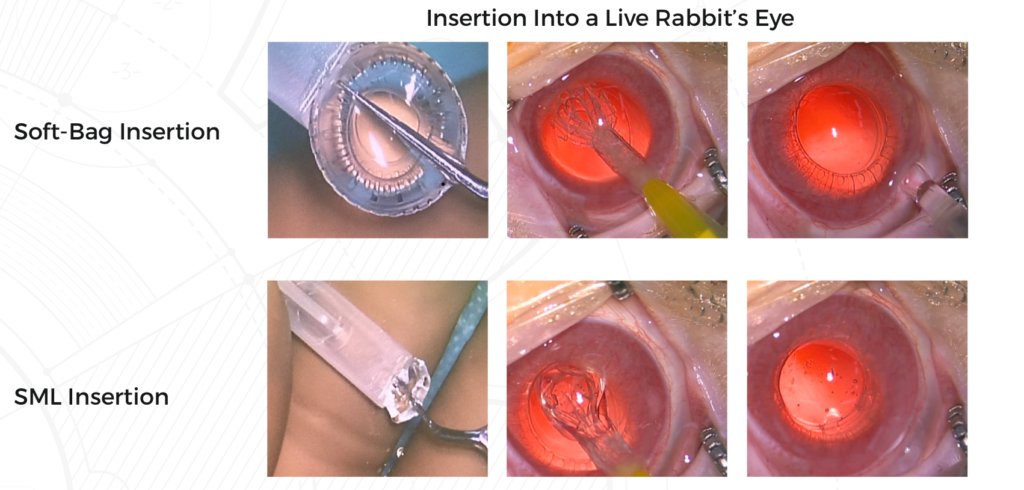
- The Soft-Bag was fixed into the injector for a 3.0mm incision. It was then inserted into a live rabbit's capsule. Thereafter, the SML was inserted into the Soft-Bag using the same injector.
- Combining and inserting the two devices into the capsule was done easily and safely.
Evaluation: Prevention of Capsule Equator Adhesion and Capsule Hardening
Four Months Post-Insertion into the Live Rabbit’s Capsule
- The capsule remained clear and lens epithelial cells regrowth along with capsular fibrosis did not occur four months postoperatively.
- This indicates that capsule equator adhesion and capsule hardening were prevented.
Soft-Bag と SML の成果のまとめ
- 1動物を使った実験で、Soft-Bag と SML は 3.0 mm切開から水晶体膜に安全容易に挿入され連結される ことを確かめた。
- 2生体の兎を使った実験で、Soft-Bag・SML 連結体は、水晶体膜の癒着と膜の硬化を防止すると考え られた。
< Soft-Bag と SML の今後のスケジュール >
- ・今後、インドにおいて、非臨床試験とそれに続く SANKARA 病院での臨床評価を行う。
Current Issues for Presbyopia Correction (Part 2)
Accommodating Intraocular Lens with Shape-Changing Lens Having a Tube

- The A-IOLs using forward and backward movements of a mono-focal lens induce limited accommodation power whereas A-IOLs causing the change in the shape of lens fluid induce a large accommodation power.
- The illustrations above show an A-IOL which is under clinical studies for the 'CE' mark certification. This IOL induces the accommodation power by changing a lens' shape; this is induced by the movement of silicon oil from the outer tube to the center of the optic. The silicon oil movement occurs due to the outer wall movement of the tube being induced by the ciliary muscle, zonules, and capsule equator movement.
- This IOL has been miniaturized three times during clinical studies. The first model needs a 4.5mm incision and a recent model requires a 3.5mm incision.
- This IOL must be large enough and the capsule equator must attach to the tube with sufficient tension for inducing the above-mentioned movement. Therefore, this IOL has a dilemma that the miniaturized model induces a weak contact between the outer wall of the tube and the capsule equator because of which it cannot have a mobility.
Adjustable intraocular lens whose optical part changes shape

- The illustration above shows an A-IOL which is under clinical study in the USA and is reported to induce an accommodation power of 1.5D.
- This IOL consists of two parts which are: 1. The frame with a lens that expands the capsule. 2. The fluid lens with silicone oil changes its shape in the frame.
- This IOL has no spring function in a vertical direction. It has a mechanism that allows the equatorial capsule and zonules to push the frame section so that the fluid lens becomes swollen at the time of near sight.
- We figure that this IOL is difficult to move in the capsule because the zonules cannot push the capsule and the frame.
Solutions We Offer for Presbyopia Correction (Part 2)
Solutions by Soft-Bag & Active-Move Lens (AML) Combination
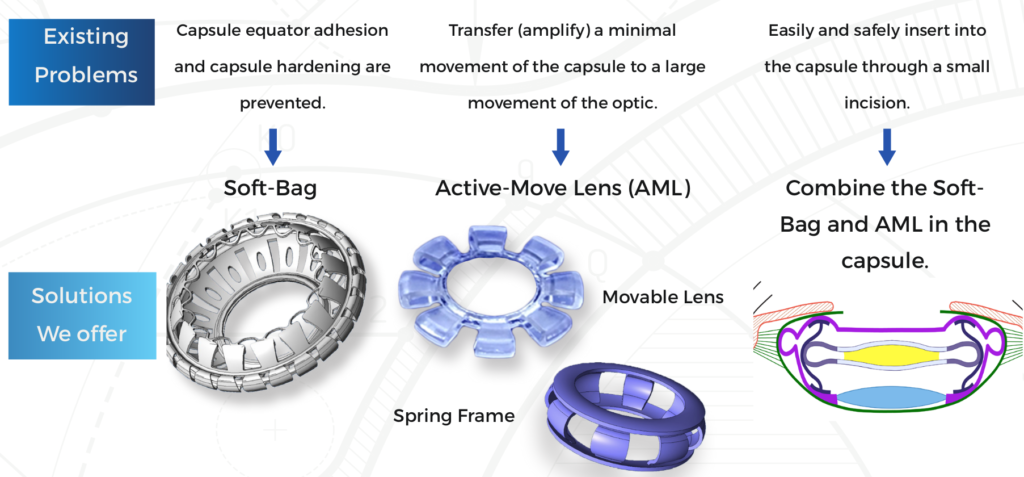
- We are developing an Active-Move Lens (AML) that moves in the soft-bag and induces a greater accommodating power than a Simple-Move Lens.
- The Soft-Bag has a convex lens that adopts patient’s refraction in the rear ring.
- The AML consists of a movable lens part and a spring frame part. The moving lens part has multiple U-shaped arms connecting it to the lens optic. The lens optic has two moving round plates, with silicone gel being confined internally.
- The spring frame part has two rings within it, with multiple movable C-shaped arms being connected.
Accommodation Function of the Soft-Bag & AML Combination

- The accommodation function of the Soft-Bag & AML combination is performed by the Soft-Bag receiving the capsule’s change and the AML optic changing its surface shape.

- Structural analysis showed that the optic curvature changes from 15mm to 7.5mm, which indicates around 20D of accommodation power.
Results of the Active-Move Lens
Production of the Movable Lens of Active-move Lens (AML)

- We made a movable lens part of an AML.
- This part has a lens optic in which silicone gel is confined between the two movable disc plates which are made of silicone. It is a safe and durable IOL that has minimal risk of liquid leakage.
- The surface curvature of the optic, measured by a laser 3D measuring machine, showed a change from the black to the red line and indicated 18.6D accommodation power when the diameter of the movable lens part was shortened from 9.0mm to 8.6mm by a ring-shaped jig.
Soft-Bag と AML の成果のまとめ
- ・AML の可動レンズ部を作製し、直径を 0.4 mm縮めた時、18.6D の屈折力の変化を示すことを確認した。
Soft-Bag と AML の今後のスケジュール
・今後、可動レンズの最適化を行う。また、AML用の Soft-Bag とスプリングフレーム部の作製と最適化
を行う。
そして、宮崎大学での動物実験で最適化した Soft-Bag と AML の機能性と安全性を検証する。
Research & Production Timeline
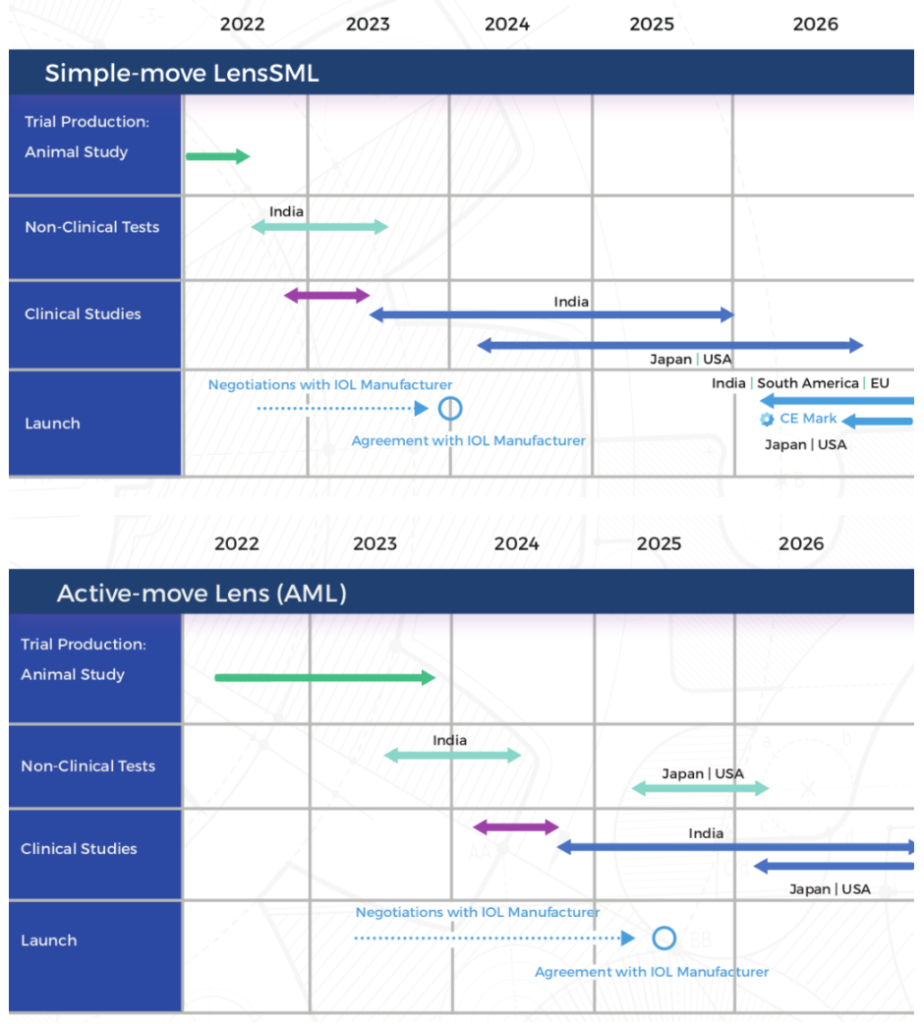
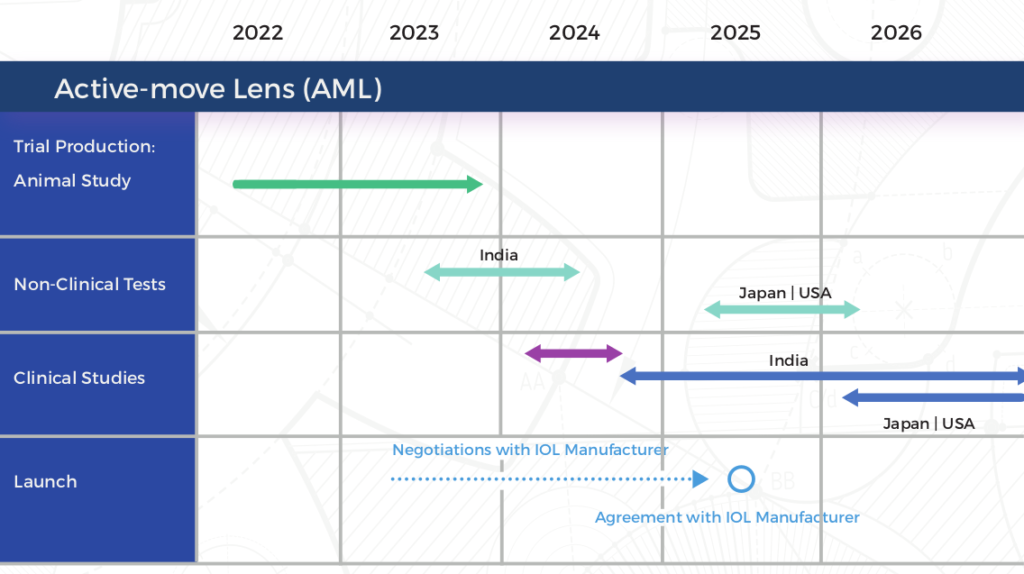
事業化イメージ
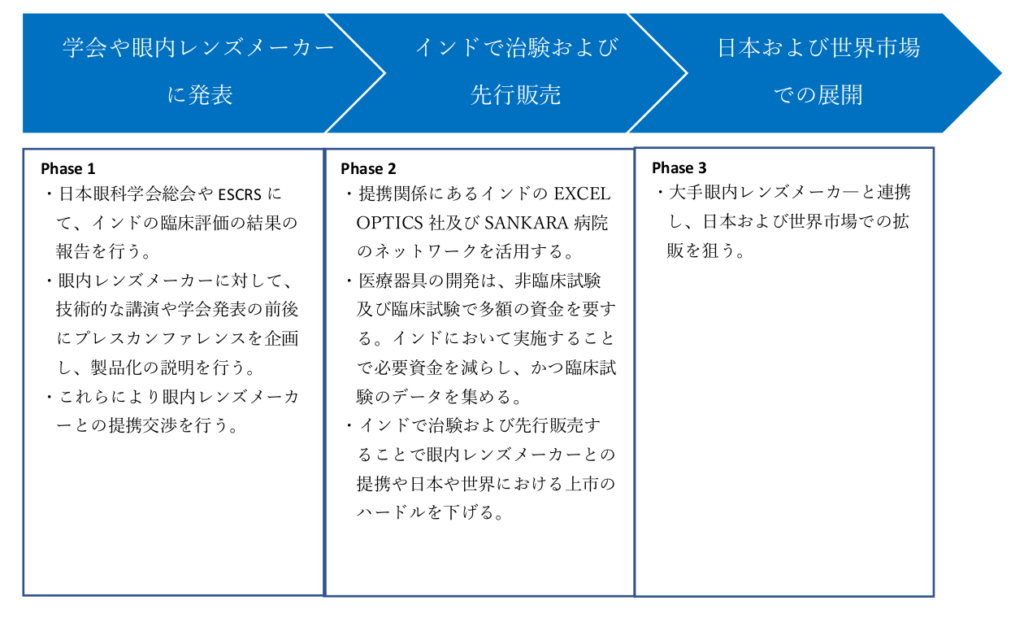
Market Size and Social/Economic Impacts
- The Accommodating Intraocular Lens (A-IOL) we are developing will be used in two ways — for cataract surgeries and surgical correction of presbyopia.
- For cataract surgeries, the number of conventional IOLs used annually is approximately 1.8 million in Japan, 5.6 million in the USA, and over 30 million in other global regions. The global market size is approximately 400 billion yen. However, ordinary IOLs are not able to correct presbyopia. Some also have a high probability of allowing secondary cataracts (lens capsule opacity due to re-proliferation of the lens' epithelial cells) to occur. We anticipate the Simple-Move Lens (SML) to completely prevent the occurrence of secondary cataracts and to exhibit mild accommodative power. If the SML is used in 20% of all IOL users globally, this equates to 5.6 million pieces of this lens being used across the world. This amounts to sales of over 300 billion yen should the price be set at 50 000 yen a piece.
- The Active-Move Lens (AML) on the other hand, is expected to be used as a premium lens capable of curing presbyopia during cataract surgery in approximately 10% of all cataract operations primarily in developed nations. Considering that multifocal IOLs with insufficient accommodative functions are currently marketed at 50 000 to 100 000 yen apiece, we forecast total annual sales to reach 200 billion yen if each piece is sold at 200 000 yen for roughly one million operations primarily in developed nations.
- For the surgical correction of presbyopia, the market is expected to grow rapidly. Currently, the insertion of a multifocal IOL during cataract surgery is usually conducted for the correction of presbyopia and the insertion of a pinhole lens (corneal inlay) into the cornea. LASIK surgery for presbyopia correction and other procedures have recently increased in popularity. However, these operative procedures have not fully satisfied patients because of the unnatural postoperative vision patients experience. The SML and the AML, which we are developing, can correct presbyopia with fewer side effects and theoretically induce natural eyesight.
- Assuming that one out of every 200 people with presbyopia in the world (approximately 2 billion people) receives implantation of the SML or the AML for correction of presbyopia and that each lens is used for 50 million people (100 million lenses) annually, annual sales forecast to reach 2.5 trillion yen.
- Thus, the development of the SML and the AML will have huge economic impacts. Furthermore, under the trend of an ageing population in many developed nations, correction of presbyopia and restoration of clear vision during the formative years of elderly people will contribute to a reduction in traffic accidents by elderly people and allow them to read fine details without glasses. This, in turn, fosters a society in which the elderly can remain active and productive while ageing .
Conference Presentation
- On the 19 th of April 2018, Dr Akura gave a presentation at the 122 nd Annual Meeting of the Japanese Ophthalmological Society, International Symposium. His presentation pertained to the development of the Simple-Move Lens (SML).


